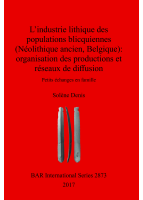Description
La culture Blicquy/Villeneuve-Saint-Germain marque la fin des traditions danubiennes (Néolithique ancien) dans le nord de la France et en Belgique. Les onze sites étudiés sont localisés en Belgique. Deux aires d’implantation, distantes d’une centaine de km sont distinguées (en Hainaut et en Hesbaye). La mise en œuvre d’une analyse techno-économique de l’industrie lithique blicquienne visait à répondre à un double objectif: restituer l’organisation socio-économique de la production lithique et les relations entretenues entre les différentes zones de peuplement de cette culture. Cette étude souligne la structure duale de la production lithique et suggère une spécialisation intra- voire intercommunautaire de cette production laminaire. L’étude de la diffusion des matières premières illustre l’intensité des relations entre les villages, impliquant fréquemment le déplacement de tailleurs. Ce travail souligne à nouveau l’importance des échanges dans la vie socio-économique de ces premières communautés agro-pastorales.
In the north of France and Belgium, the Blicquy/Villeneuve-Saint-Germain culture marks the end of the Danube traditions (Early Neolithic Period). The eleven sites studied are all found in Belgium. Two settlement areas, separated by 100 km, are highlighted (in Hainaut and in Hesbaye). The author has performed an analysis of the technical and economical characteristics of the Blicquian lithic industry, in order to describe the socio-economic organisation relating to lithic production as well as the relationships between the different settlement areas of this culture. The study concludes that there were two distinct types of production and suggests some kind of specialisation in the laminar production in the community, or even among several communities. The study of the diffusion networks of siliceous raw materials illustrates the intensity of relations between villages, often involving the movement of knappers, demonstrating further the importance of exchanges for the socio-economical welfare of those agro-pastoral communities.AUTHOR
Solène Denis est une jeune chercheuse, ayant soutenu sa thèse de doctorat à l’Université Paris Ouest Nanterre la Défense en décembre 2014. Post-doctorante rattachée à l’UMR 7055 « Préhistoire et Technologie », ses recherches portent sur les industries lithiques des premières communautés agro-pastorales de l’Europe du Nord-Ouest. Solène Denis is a young researcher, and presented her doctoral thesis to the Université Paris Ouest Nanterre la Défense in December 2014. She is currently working with the ‘Prehistory and Technology’ Unit (UMR7055), and her research focuses on the lithic industries of the first agro-pastoral societies of north-western Europe.
REVIEW
‘Solène Denis has studied thousands and thousands of unpublished flaked artefacts, which, in itself, constitutes an appreciable contribution to the knowledge of the region and period. … This volume is a major contribution in this field of research, both for the methodology and the results, [and offers] an excellent demonstration of the heuristic potential of a good technological approach.’ Prof. Catherine Perlès, Maison de l’Archéologie et de l’Ethnologie











